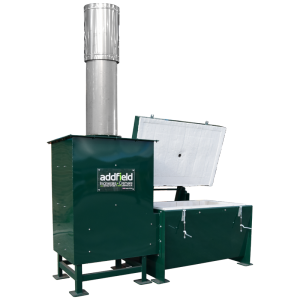
16/11/20
When is Lambing Season and what results can you expect this year?
The lambing calendar generally ties very closely into the arrival of spring each year, as Farmers everywhere begin to prepare themselves for what is often a very hectic lambing season. Incinerators may be the last thing that you would think of at this time of year, however, with the large numbers of new lambs being delivered, there is a downside. As the numbers of lambs increase so too does the numbers of dead lambs and ewes, records show that there is a potential increase of fallen stock to up to 30 percent of the flock during this period. This additional burden can create what could become a serious problem for farmers to deal with.
The quality of any lambing season is dependent upon a number of factors including the one topic we Brits can’t get enough of talking about, the weather. The impact of the weather brings many unseen effects, from the slowing in the growth of grass in grazing areas, reducing the nutritional intake of Ewes during pregnancy to the risks created by poor access to farmland in times of extreme snow.
With the average Ewe giving birth to 1-2 lambs it is not uncommon for some to have as many as 5 at a time. While farmers will be kept busy delivering and rearing the lambs, one issue that will not fail to go away is the safe treatment of dead lamb carcasses ensuring that they do not pose any threat to livestock or environment.
Different breeds of sheep have unique resistances and weaknesses, therefore knowing your herd is essential to controlling your losses. An astounding 30% of these are recorded to take place in-utero, and before formal Lambing actually begins. Issues such as twin lamb disease, undernourished births, and increased risk of prolapse can all be factors that affect the flock numbers and contribute towards the success and failure of the season. Causes of morbidity can include a wide array of factors including birth defects and infections such as Coccidiosis.
Are you prepared for Lambing Season?
With the inevitable fallen stock needing to be dealt with promptly there are currently a number of options. These can include Burial, Rendering or Incineration. The most viable for long-term management and sustainable BioSecurity will always be incineration, especially when carried out on site.
Burial
With Burial being unlawful in many countries except in extreme circumstances such as when flocks are devastated by environmental conditions. This last occurred in the UK in 2013 following extremely heavy snow in some regions, which limited accessibility. Burial is highly insecure due to the risks for the environment and biosecurity of the land and farm from the dead lamb carcass left to decompose into the ground. As previously mentioned there can be many causes of mortality including disease which should not be put back into the environment.
Offsite Rendering and Incineration
Farmers pay on average of £15 per lamb and £20 per ewe for removal and destruction, (compare this to the average fuel cost of only £3 to incinerate an adult Ewe using an Addfield Machine). When you consider that an average farmer could experience losing up to 100 sheep the cost of a bad season could prove very expensive running into several thousands of pounds a year. These collections are often via a bin collection service where the animals are left for days if not weeks to be collected. At busy times you can expect extended waiting times between collections during lambing season increasing the risks of contamination as decomposing lambs and ewes lay unattended on farmland creating massive risks to biosecurity alongside potential fines for the landowner.
Onsite Incineration
By having an on-site incineration solution, farmers are able to rapidly manage any fallen animals reducing the risks of cross-contamination and maintaining bio-security. They are also able to maintain a continuously clean environment without relying on waiting for collection and the potential spread of diseases that this could pose.
Able to be installed without complication Addfield incinerators are designed for ease of use and have been trusted by farmers for over 35 years with many machines being in continuous operation for decades. This ensures a clear return on investment as lambing season is not the only time that farmers need to have fallen stock removed.
With the additional options of many farmers being able to receive up to 40% funding towards their incinerator, it quickly becomes the sensible choice for managing fallen stock not only during lambing season but also all year round.
What will this years Season bring?
While the past few years have been on the whole rather mild. The regular snowfall we have seen so far could indicate a potential repeat of 2013, as we seem to be in the midst of cold spell this year. This weather can have a drastic impact on lambing especially if it continues to come with high levels of snowfall which we have already seen in the Scottish Highlands.
While you may not be able to prevent the initial numbers of dead lambs during lambing season you can take measures to protect yourself, your flock and your farm from unnecessary impact and reduce losses through careful management
Ask yourself ‘How much is fallen stock costing you?’
Before the season begins it may be worth looking back at your previous year’s mortality rates and cost of managing it throughout the season and beyond. Could you have saved more by having your own incinerator on site? Being prepared can stop you from being out of pocket especially as you can easily expect over 20 years usage from an Addfield Incinerator that is properly maintained and serviced.
We have machines to suit all sizes of operation. Yet if you do not believe that your farm is large enough to manage its own incineration there are numerous ‘Incineration Co-operatives’ around the country that you could replicate and bring in additional income through helping your neighbouring farmers manage their fallen stock.
It’s better to be prepared, so contact one of our sales team today and find out how much you could save as well as if you are eligible for up to 40% match funding on your new incinerator.
How much could you save over the next few years?
For further information visit:
Recommended Addfield Incinerators for lamb and sheep disposal.
The essentials of Biosecurity on Sheep Farms.
Extreme Snowfall in 2013 resulted in massive loss to flock.
DEFRA Guidelines for Animal by-product control.
DAERA Guidelines for managing Fallen Stock.
National Fallen Stock Guidelines in the event of extreme weather and natural disasters.
For the latest guidelines visit DEFRA.
Incineration Co-operative and rising costs in North Wales
To learn more about the agricultural range of incinerators from Addfield click here.
- British Designed.
British Built. - World leaders in
incineration technology. - Unrivalled build quality
& machine longevity. - Distributed to more
than 150 countries. - Environmentally
Responsible. - Trusted partner, over
40 years experience.






